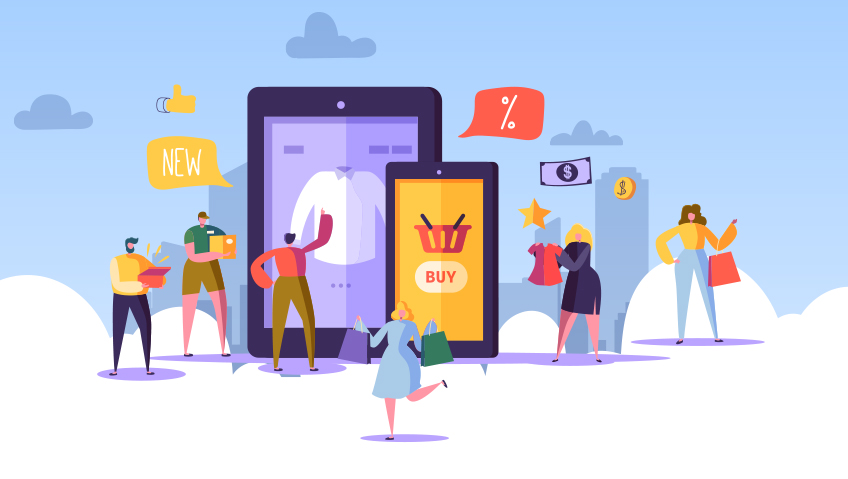The COVID-19 pandemic changed the face of retail in 2020—and possibly forever. Unprecedented challenges led to adopting new trends throughout the industry and strengthened or sped up the adoption of others. From a major spike in e-commerce and contactless shopping to the development of new retail technologies, shopping in 2021 is an evolving experience that promises to continue to push the envelope to deliver what today’s consumers expect and demand.
One of the most obvious consequences of the pandemic has been the dramatic shift away from brick-and-mortar shopping. E-commerce was already gaining substantial ground before the shutdown, but the pandemic drove more consumers online, leading to an additional $105 billion in U.S. online revenue in 2020. Online sales reached a total of $791.70 billion that same year, up 32.4 percent from $598.02 billion the previous year, Digital Commerce 360 reports.
It is worth noting that the trend has continued into 2021, and some of the figures certainly reflect the spike in COVID-19 cases in January of 2021, suggesting that consumers may continue to take advantage of the convenience online shopping provides.
Online sales increased 39 percent year over year in the first quarter of 2021, almost three times the 14 percent increase in the first quarter of 2020, and faster than the third and fourth quarters of 2020, according to Digital Commerce 360.
As of March 2021, consumers made 43 percent of their monthly retail purchases online, according to Square Inc. In response, retailers have continued to bolster their e-commerce options, with 88 percent now selling online. This shift has become imperative in today’s retail landscape; among retailers that sell online, 58 percent of their revenue is made up of online sales, Square Inc. reports.
There is increasing pressure for retailers to adopt new technologies and methods to woo consumers who have abandoned traditional in-person shopping or who want an in-person shopping experience with less contact and more convenience.
Virtual shopping is one innovation that gained a strong foothold during the pandemic and will likely remain popular. Last year, many quarantined shoppers, particularly those in Asia, got their shopping fix from live stream technology when deprived of traditional in-person shopping sprees, Brandwatch reports. These shoppers enjoyed interacting via a blend of platforms including live chatting on social media, live streaming, and DTC live selling. Hosted by popular influencers and celebrities, these interactive shows featured everything from makeup and skincare to fitness and healthy eating—any topic with a related product to sell. More than one in three retailers will invest in live stream shopping this year, Square Inc. reports.
Consumers are not ready to give up in-store shopping entirely, however. More than nine in ten consumers “still crave the thrill of shopping inside a physical store,” Square Inc. reports. Of these consumers, almost 50 percent say they miss browsing and “getting out of the house.” Two in five miss getting a purchase instantly, rather than having to wait for shipping.
But, today’s consumers expect a next-generation in-person experience, rather than traditional brick-and-mortar shopping. In short, they want the best of both worlds. Shoppers want to browse aisles, enjoy unexpected finds, and choose their own products—but they also want to keep many of the new conveniences that retailers have had to adopt since the onset of the pandemic. The result will likely be a symbiotic relationship between e-commerce and in-person shopping, where one complements the other, Square Inc. points out.
At the onset of the pandemic, retailers began offering consumers the option to try on makeup and apparel virtually. ‘Virtual try on’ is one area of technology that continues to show promise, even as social distancing restrictions ease. Forward-thinking clothiers are rolling out digital fitting rooms that utilize virtual technology to enhance and simplify the traditional fitting room experience.
Mango is one of the latest fashion retailers to offer an ‘Internet of things mirror’, Current Daily reports. Shoppers simply scan clothing tags to request different sizes and colors or to view suggestions of pieces that would complete the look they hope to create; sales associates receive an alert via a digital watch.
Mango is currently testing the technology with the hope of implementing it in the brand’s top stores around the world. The Spanish clothier is just the latest retailer to demonstrate an interest; Rebecca Minkoff, Ralph Lauren, and Tommy Hilfiger have also been experimenting with the new technology, Current Daily reports.
Touch-free checkout is a technology that today’s consumers have come to expect as they return to in-store shopping. Amazon became a trailblazer in this area with the implementation of its Just Walk Out technology, which lets shoppers grab the products they want and then, as the name implies, just walk right out of the store. The process is remarkably simple for on-the-go consumers. They enter the store using a credit card, the technology detects what items the shopper takes from—or returns to—a shelf, and then, after the shopper leaves the store, Amazon bills their credit card.
While not as dramatic as Amazon’s Just Walk Out experience, other retailers continue to expand their contactless and self-checkout options. One of the most popular solutions is mobile cashier or mobile scan, in which shoppers simply scan items with their phones and pay using an app. In addition to upholding public health precautions during the pandemic, the technology saves shoppers time since they skip checkout lines.
‘Buy online, pick up in-store’ and curbside pickup are also likely to remain popular post-pandemic. These options were available before COVID-19 hit, but the introduction of social distancing really made these shopping experiences take off. More than half of consumers in the United States who bought online and picked up in-store in 2020 reported that they expect to keep using the service in the future, according to a McKinsey & Co. survey.
Shoppers flocked to big box stores during the pandemic. These retail giants had money to invest to improve the shopping experience, and they offered a variety of options consumers needed during the shutdown, including online shopping, contactless checkout, delivery, and ‘buy online, pick up in-store.’ For shoppers who had to venture into a brick-and-mortar store, the broad range of wares in big box stores allowed them to limit trips out, reducing potential exposure to COVID-19.
Last year, Amazon, Wal-Mart, Target, and Costco all enjoyed growth ranging from “very solid to explosive,” Retail Dive reports, explaining that the pandemic “had the effect of accelerating a longstanding trend of consumers ditching specialists for generalists as a matter of convenience and price.”
On the flip side, the pandemic also created some advantages for local retailers that may come into play in the future. Almost three out of four consumers prefer delivery over pickup when they are online shopping, Square Inc. reports. But, only 37 percent of retailers provide same-day delivery. Local retailers have an edge in this area because their proximity to the consumer allows faster delivery, and their smaller size may allow for a more efficient turnaround. We have yet to see if local retailers will manage to take full advantage of this opportunity and woo shoppers back or if consumers will continue to choose the big retail generalists in ever-increasing numbers.
While the race between local retailers and the retail giants is still on, one factor is clear. The retail landscape has been reimagined during the pandemic and retailers of all shapes and sizes will have to evolve to keep up. From virtual reality to Just Walk Out technology, the store of the future is here today, and as modern demands continue to drive the industry forward, this is only the beginning.






